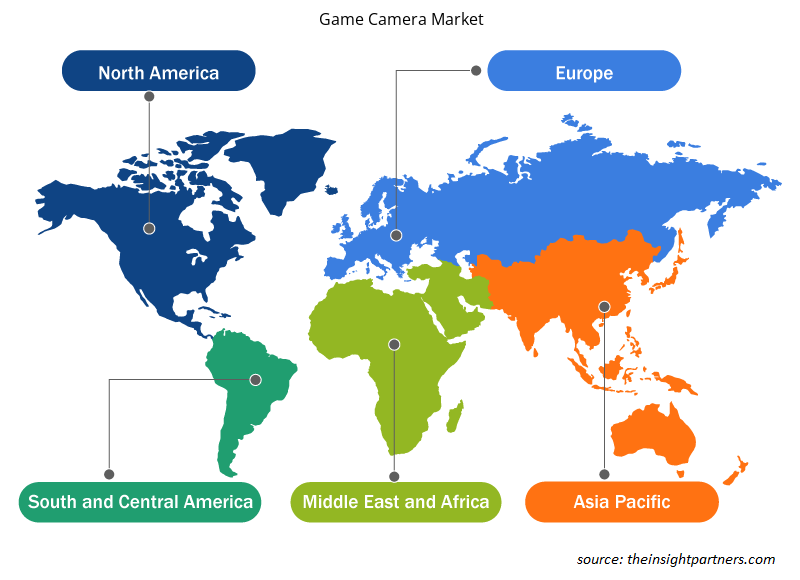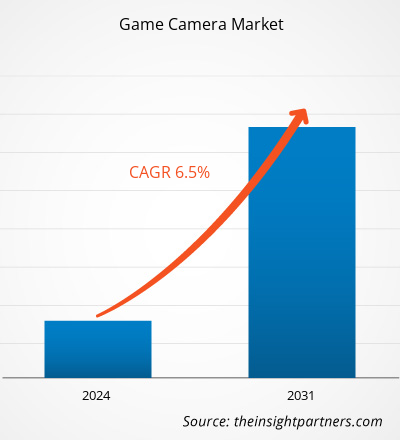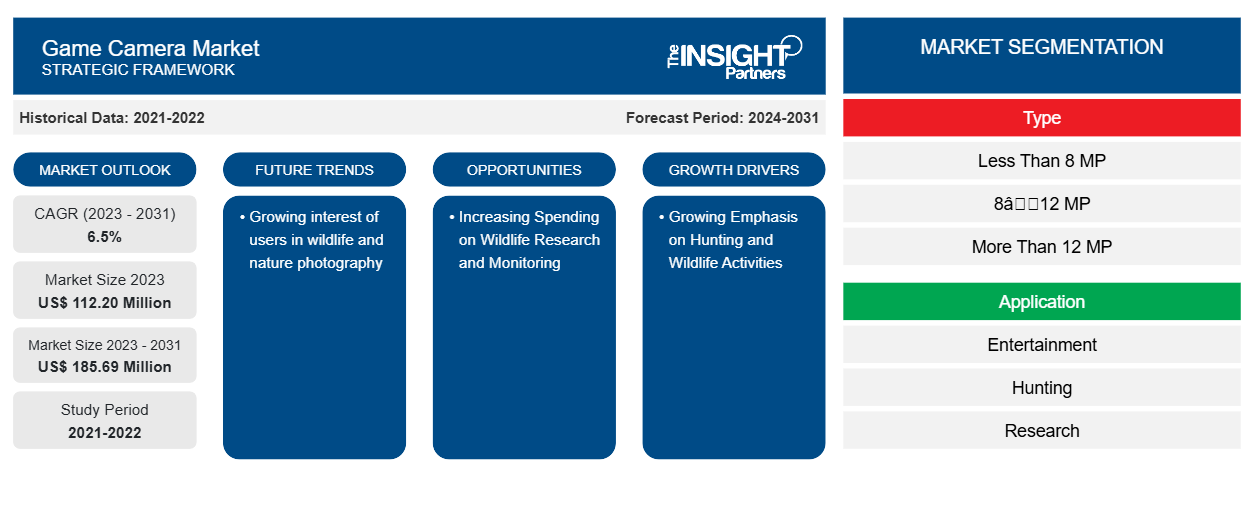Se espera que el tamaño del mercado mundial de cámaras para juegos crezca de US$ 112,20 millones en 2023 a US$ 185,69 millones en 2031; se anticipa que se expandirá a una CAGR del 6,5% entre 2023 y 2031. Es probable que el creciente interés de los usuarios en la fotografía de vida silvestre y naturaleza siga siendo una tendencia clave del mercado de cámaras para juegos.CAGR of 6.5% from 2023 to 2031. The growing interest of users in wildlife and nature photography is likely to remain a key game camera market trends.
Análisis del mercado de cámaras para juegos
Se prevé que el aumento de los gastos en investigación y vigilancia de la vida silvestre siga siendo un importante motor del mercado. Varias razones contribuyen a la expansión del negocio de las cámaras para la caza, entre ellas, un mayor conocimiento sobre la protección de los animales, las iniciativas de las autoridades de todo el mundo para mejorar el turismo de vida silvestre y una creciente demanda de experiencias de viaje genuinas y sostenibles.
Descripción general del mercado de cámaras para juegos
Una cámara de caza, a menudo llamada cámara de rastreo o cámara de vida silvestre, es un dispositivo especializado que se utiliza en el sector de la recreación al aire libre para grabar fotografías y películas de alta calidad de animales. Estas cámaras están diseñadas para sobrevivir a las duras circunstancias al aire libre y brindar a las empresas información importante sobre el comportamiento y los patrones de numerosas especies animales. Las cámaras de caza están equipadas con potentes sensores de movimiento y tecnologías infrarrojas, lo que les permite identificar y capturar fotografías de animales en sus hábitats naturales sin molestarlos. Esta tecnología permite a empresas como organizaciones de conservación de la vida silvestre, proveedores de equipos de caza y fotógrafos de naturaleza recopilar datos críticos y monitorear las poblaciones de animales de una manera no invasiva.
Personalice este informe según sus necesidades
Obtendrá personalización en cualquier informe, sin cargo, incluidas partes de este informe o análisis a nivel de país, paquete de datos de Excel, así como también grandes ofertas y descuentos para empresas emergentes y universidades.
-
Obtenga las principales tendencias clave del mercado de este informe.Esta muestra GRATUITA incluirá análisis de datos, desde tendencias del mercado hasta estimaciones y pronósticos.
Factores impulsores y oportunidades del mercado de cámaras para juegos
Creciente énfasis en la caza y las actividades de vida silvestre para favorecer el mercado
La caza y las actividades con animales han ganado popularidad en los últimos años. Los entusiastas de las actividades al aire libre, tanto los cazadores expertos como los novatos, se sienten cada vez más atraídos por la emoción de la caza y la oportunidad de reconectarse con la naturaleza. Este creciente énfasis en la caza y las actividades con animales ha dado como resultado una mayor demanda de equipos innovadores que puedan mejorar toda la experiencia. La cámara para juegos es un equipo que ha recibido mucha atención. Las cámaras para juegos, a veces conocidas como cámaras de seguimiento, se han convertido en una herramienta popular para los cazadores debido a sus múltiples beneficios. Su pequeño tamaño es una de las principales razones de su popularidad.
Aumentar el gasto en investigación y vigilancia de la vida silvestre
La creciente inversión en investigación y monitoreo de la vida silvestre está impulsando la demanda de cámaras de caza. Las cámaras de caza se utilizan comúnmente para monitorear animales en santuarios de vida silvestre, así como para investigación zoológica y biológica. La gama de aplicaciones de las cámaras de caza en seguridad e investigación al aire libre se ha ampliado, lo que contribuye al desarrollo del mercado. Las cámaras de caza, a menudo conocidas como cámaras trampa, son cámaras remotas que se activan por el movimiento en su entorno, como la presencia de animales. Tienen sensores de movimiento , generalmente infrarrojos pasivos (PIR) o infrarrojos activos (AIR), que detectan el movimiento utilizando un haz de luz infrarroja. La captura con cámara es una técnica para capturar animales salvajes cuando los investigadores no están presentes, y se ha empleado en estudios ecológicos durante décadas.PIR) or active infrared (AIR), that detect movement using an infrared light beam. Camera trapping is a technique for capturing wild animals while researchers are not present, and it has been employed in ecological studies for decades.
Análisis de segmentación del informe de mercado de cámaras de juego
Los segmentos clave que contribuyeron a la derivación del análisis del mercado de cámaras de juego son el tipo y la aplicación.
- Según el tipo, el mercado se divide en menos de 8 MP, de 8 a 12 MP y más de 12 MP. El segmento de 8 a 12 MP tuvo una mayor participación de mercado en 2023.
- En términos de aplicación, el mercado se divide en entretenimiento, caza, investigación y otros. El segmento de caza tuvo una mayor participación de mercado en 2023.
Análisis de la cuota de mercado de cámaras de juego por geografía
El alcance geográfico del informe de mercado de cámaras de caza se divide principalmente en cinco regiones: América del Norte, Asia Pacífico, Europa, Oriente Medio y África, y América del Sur/América del Sur y Central. América del Norte dominó el mercado de cámaras de caza en 2023. Esto se debe a los continuos avances tecnológicos; las cámaras de caza han experimentado una evolución significativa, lo que ha dado como resultado una mayor confiabilidad, adaptabilidad y conveniencia. Esto ha llevado a una creciente demanda de cámaras de caza celulares entre los consumidores, en particular los cazadores, los entusiastas de las actividades al aire libre y las personas que buscan soluciones de seguridad para el hogar. Las cámaras de caza celulares ofrecen varios beneficios, como monitoreo remoto, transmisión instantánea de imágenes y la capacidad de capturar la actividad e intrusiones de la vida silvestre en tiempo real. Esto las ha hecho populares para la caza, la observación de la vida silvestre, la fotografía y la seguridad del hogar.
Perspectivas regionales del mercado de cámaras de juego
Los analistas de Insight Partners explicaron en detalle las tendencias y los factores regionales que influyen en el mercado de cámaras para juegos durante el período de pronóstico. Esta sección también analiza los segmentos y la geografía del mercado de cámaras para juegos en América del Norte, Europa, Asia Pacífico, Oriente Medio y África, y América del Sur y Central.

- Obtenga datos regionales específicos para el mercado de cámaras de juegos
Alcance del informe de mercado de cámaras para juegos
| Atributo del informe | Detalles |
|---|---|
| Tamaño del mercado en 2023 | US$ 112,20 millones |
| Tamaño del mercado en 2031 | US$ 185,69 millones |
| CAGR global (2023 - 2031) | 6,5% |
| Datos históricos | 2021-2022 |
| Período de pronóstico | 2024-2031 |
| Segmentos cubiertos |
Por tipo
|
| Regiones y países cubiertos |
América del norte
|
| Líderes del mercado y perfiles de empresas clave |
|
Densidad de actores del mercado: comprensión de su impacto en la dinámica empresarial
El mercado de cámaras para juegos está creciendo rápidamente, impulsado por la creciente demanda de los usuarios finales debido a factores como la evolución de las preferencias de los consumidores, los avances tecnológicos y una mayor conciencia de los beneficios del producto. A medida que aumenta la demanda, las empresas amplían sus ofertas, innovan para satisfacer las necesidades de los consumidores y aprovechan las tendencias emergentes, lo que impulsa aún más el crecimiento del mercado.
La densidad de actores del mercado se refiere a la distribución de las empresas o firmas que operan dentro de un mercado o industria en particular. Indica cuántos competidores (actores del mercado) están presentes en un espacio de mercado determinado en relación con su tamaño o valor total de mercado.
Las principales empresas que operan en el mercado de cámaras de juego son:
- Boly Media Comunicaciones Co Ltd.
- Cámaras de seguimiento Browning
- Cuddeback
- Minox GmbH
- Cámara oculta (GSM para exteriores)
- Reconyx, LLP
Descargo de responsabilidad : Las empresas enumeradas anteriormente no están clasificadas en ningún orden particular.

- Obtenga una descripción general de los principales actores clave del mercado de cámaras para juegos
Noticias y desarrollos recientes del mercado de cámaras para juegos
El mercado de cámaras para juegos se evalúa mediante la recopilación de datos cualitativos y cuantitativos a partir de una investigación primaria y secundaria, que incluye publicaciones corporativas importantes, datos de asociaciones y bases de datos. A continuación, se incluye una lista de los avances del mercado:
- En enero de 2022, Cuddeback presentó una nueva línea de cámaras de rastreo celulares denominadas "Tracks". Estas cámaras están diseñadas para enfocarse en las cámaras celulares tradicionales fuera del ecosistema CuddeLink. A diferencia de las cámaras CuddeLink, que utilizan tecnología de red en malla avanzada para permitir que hasta 24 cámaras compartan un solo plan de datos celulares, las cámaras Tracks son cámaras de rastreo celulares independientes que utilizan torres celulares LTE para brindar imágenes.
(Fuente: Cuddeback, Nota de prensa, 2022)
Informe sobre el mercado de cámaras para juegos: cobertura y resultados
El informe "Tamaño y pronóstico del mercado de cámaras para juegos (2021-2031)" proporciona un análisis detallado del mercado que cubre las siguientes áreas:
- Tamaño del mercado y pronóstico a nivel global, regional y nacional para todos los segmentos clave del mercado cubiertos bajo el alcance
- Dinámica del mercado, como impulsores, restricciones y oportunidades clave
- Principales tendencias futuras
- Análisis detallado de las cinco fuerzas de Porter y PEST y FODA
- Análisis del mercado global y regional que cubre las tendencias clave del mercado, los principales actores, las regulaciones y los desarrollos recientes del mercado.
- Análisis del panorama de la industria y de la competencia que abarca la concentración del mercado, el análisis de mapas de calor, los actores destacados y los desarrollos recientes
- Perfiles detallados de empresas
- Análisis histórico (2 años), año base, pronóstico (7 años) con CAGR
- Análisis PEST y FODA
- Tamaño del mercado, valor/volumen: global, regional y nacional
- Industria y panorama competitivo
- Conjunto de datos de Excel
Informes recientes
Informes relacionados
Testimonios
Razón para comprar
- Toma de decisiones informada
- Comprensión de la dinámica del mercado
- Análisis competitivo
- Información sobre clientes
- Pronósticos del mercado
- Mitigación de riesgos
- Planificación estratégica
- Justificación de la inversión
- Identificación de mercados emergentes
- Mejora de las estrategias de marketing
- Impulso de la eficiencia operativa
- Alineación con las tendencias regulatorias























 Obtenga una muestra gratuita para - Mercado de cámaras de juego
Obtenga una muestra gratuita para - Mercado de cámaras de juego